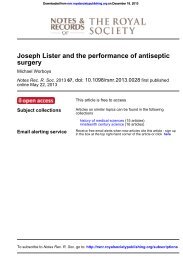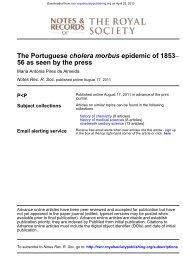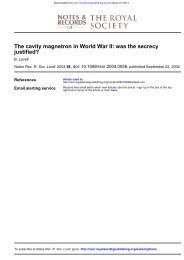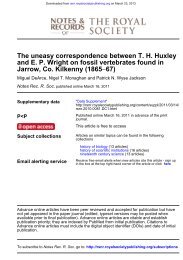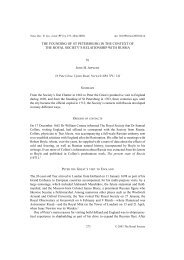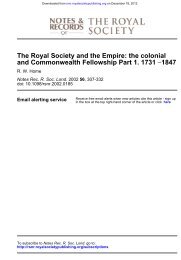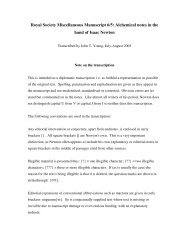an unpublished letter from henry oldenburg to johann heinrich rahn
an unpublished letter from henry oldenburg to johann heinrich rahn
an unpublished letter from henry oldenburg to johann heinrich rahn
You also want an ePaper? Increase the reach of your titles
YUMPU automatically turns print PDFs into web optimized ePapers that Google loves.
Downloaded <strong>from</strong><br />
rsnr.royalsocietypublishing.org on December 6, 2012<br />
Letter <strong>from</strong> Henry Oldenburg <strong>to</strong> Joh<strong>an</strong>n Heinrich Rahn 257<br />
item de regulis Motus, [vi] Percussionis, et Hydrostatica; 62 Jacobi Gregorii Exercita[ti]ones<br />
Geometriae; 63 Nicolai Merca<strong>to</strong>ris Logarithmotechnia. 64 sub praelo nunc sud<strong>an</strong>t Jeremiae<br />
Horroxii Astronomica a D[oc<strong>to</strong>]re Wallisio digesta. 65<br />
Cum c<strong>an</strong>dide adeo Instrumen<strong>to</strong>rum Opticorum a Te para<strong>to</strong>rum communica[ti]onem<br />
offeras, liberalitatem tuam amplexamus, et quae proficisci a nobis rec[og]noscimenti loco<br />
poterunt, summa lubentia repollicemus. Qua ratione Hookius noster Micrographiae suae figuras<br />
adeo ampliatas conspicere potuerit, ipse in Libri illius praeloquio enarrat; 66 q[uo] d quis Anglici<br />
sermonis p[er]itus facili negotio interpretari Tibi poterit. Fas mihi – 67 fuerit epis<strong>to</strong>lam h<strong>an</strong>c protrahere,<br />
cuj[us] nimine jam prolixitati veniam pe<strong>to</strong>. Vale, Vir Eximie, et doctrinae atq[ue] Virtutis<br />
Tuae Cul<strong>to</strong>ri studiosiss[im]o faue.<br />
Dabam Londini 10 Junij 1671 68<br />
Tr<strong>an</strong>slation<br />
Henry Oldenburg, Secretary of the Royal Society, sends greetings <strong>to</strong> the most distinguished <strong>an</strong>d<br />
most learned Mr Joh<strong>an</strong>n Heinrich Rahn, Secretary-Counsellor of Zurich.<br />
Distinguished Sir,<br />
Since it falls <strong>to</strong> me, more th<strong>an</strong> <strong>to</strong> <strong>an</strong>yone else here in Engl<strong>an</strong>d, <strong>to</strong> conduct philosophical<br />
correspondence, I thought it al<strong>to</strong>gether necessary <strong>to</strong> add my humble labour <strong>to</strong> that of my friend<br />
the most eminent Mr Haak when he was replying <strong>to</strong> your most recent <strong>letter</strong>. To begin with, let me<br />
indeed say what a pleasure it is for us <strong>to</strong> learn that there are also distinguished men in Switzerl<strong>an</strong>d<br />
(among whom you occupy, by right, the first place) whose minds <strong>an</strong>d h<strong>an</strong>ds are dedicated <strong>to</strong> the<br />
cultivation of physics <strong>an</strong>d mathematics. The task at which the British Royal Society labours is<br />
assuredly a difficult one, namely, tracing the inner parts of Nature, investigating the power of Art,<br />
<strong>an</strong>d applying both <strong>to</strong> the use <strong>an</strong>d adv<strong>an</strong>tage of hum<strong>an</strong> life. This is, indeed, not a task for one<br />
nation alone; in order <strong>to</strong> achieve so great a purpose, the learned <strong>an</strong>d sharp-witted men of all countries<br />
must combine their wits <strong>an</strong>d their efforts. Once again, we judge you, most learned Sir, worthy<br />
of great praise, for having also decided <strong>to</strong> make your contribution here, <strong>an</strong>d <strong>to</strong> send us <strong>an</strong><br />
account of your studies. It gives us great pleasure <strong>to</strong> learn that you have reduced the problems of<br />
Dioph<strong>an</strong>tus <strong>to</strong> algebra; we eagerly look forward <strong>to</strong> the publication of that work in Latin. No doubt<br />
you have become aware of the work that has been done on algebra in recent years in all countries.<br />
For example, Kinckhuysen printed <strong>an</strong> introduction <strong>to</strong> algebra in Dutch in 1661; he has also<br />
published two other books, entitled De grondt der Metkonst or Analytical Conicks (1660) <strong>an</strong>d<br />
Geometrische Problemata met haën Analytical Calculus (1663). 27 Jacob Ferguson published a<br />
Labyrinthus algebriae; 28 <strong>an</strong>d Martyn Wilkens, Officina algebriae. 29 To those c<strong>an</strong> be added<br />
Smyters’s Algebra, 30 <strong>an</strong>d Fr<strong>an</strong>s v<strong>an</strong> der Huyps’s Algebra. 31<br />
A few years ago Erasmus Bartholinus’s Dioristice sive Methodus aequationum prima et<br />
secunda was published in Denmark; at the end of that treatise, a general system of algebra was<br />
promised by the author32 —who, since then, has been occupied with publishing <strong>an</strong> accurate edition<br />
of Tycho’s observations. 33 De Sluse, at Liège, has been made famous by that splendid book<br />
entitled Mesolabum, with its second part, De <strong>an</strong>alysi, et miscell<strong>an</strong>ea (1661). 34 Rinaldini’s<br />
Geometra promotus has been published in Italy; I have not yet made up my mind about it, though<br />
learned men praise it highly. [Marginal note: See the description in the Giornale vene<strong>to</strong> of this<br />
book, entitled Analytica mathematum, by Carlo Rinaldini, 3 folio volumes (Padua, 1671).] 35 At<br />
Toulouse, in Fr<strong>an</strong>ce, <strong>an</strong> edition of Dioph<strong>an</strong>tus was recently published with notes by Fermat, <strong>an</strong>d<br />
with Fermat’s ‘Inventum novum <strong>an</strong>alyticae doctrinae’, put <strong>to</strong>gether by the Jesuit de Billy <strong>from</strong><br />
various of Fermat’s <strong>letter</strong>s; 36 in it there are solutions <strong>to</strong> several numerical problems which others<br />
had given up trying <strong>to</strong> solve. This de Billy has published two volumes of Dioph<strong>an</strong>tus redivivus. 37<br />
Here in Engl<strong>an</strong>d, roughly four years ago, your own Introduction <strong>to</strong> Algebra was published<br />
in English, <strong>to</strong>gether with much additional material by Dr Pell. 38 There was also published at that<br />
time a lecture on the use of curves for solving equations, at the end of Dr Barrow’s Lectiones<br />
geometricae, 39 as also M. Dary’s Miscell<strong>an</strong>ies, on the measurement of curves. 40 What we especially<br />
desire is that someone will find <strong>an</strong>d publish <strong>an</strong> easy method for obtaining the roots of the<br />
highest equations by me<strong>an</strong>s of logarithms: knowing that Mr Pell has done useful work on that



